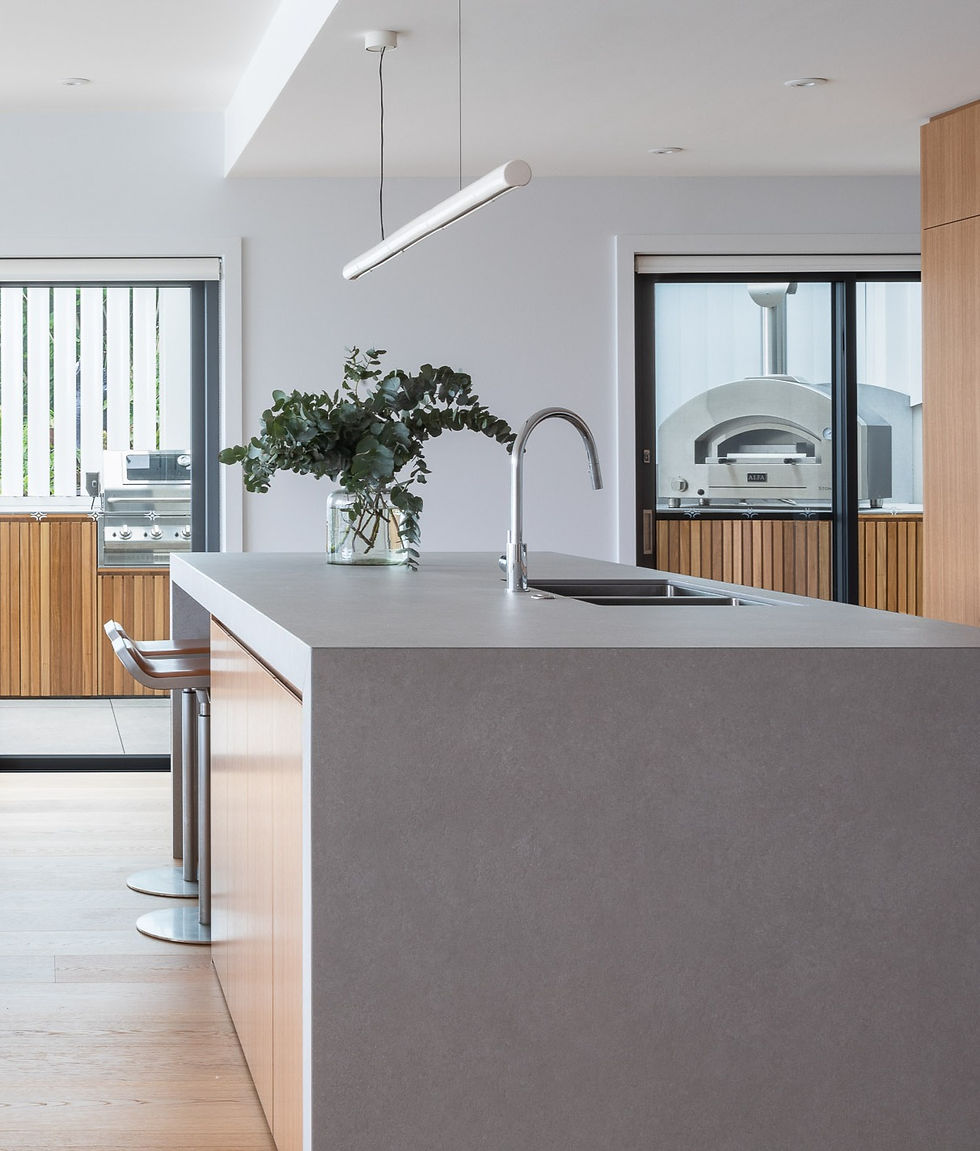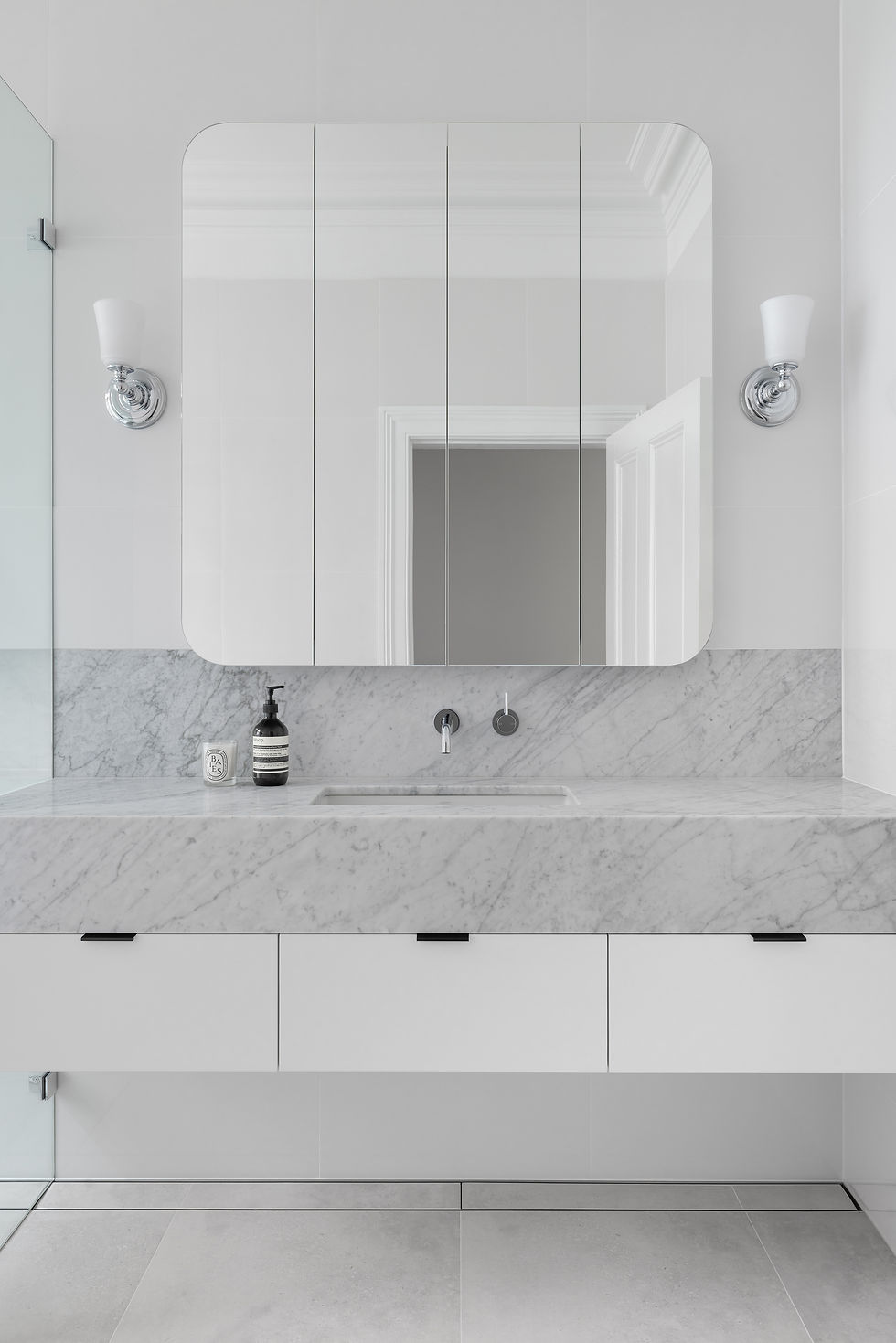Your Interior Questions, Answered by Angela
- riadocherty
- Jun 1, 2022
- 4 min read
Updated: Jul 25, 2022
Creating beautiful interiors is about balance between objects and materials, and the thought process behind each choice is measured and purposeful.
We chatted with our interior designer, Angela to get the answers and design insight to some of our most frequently asked questions, with the aim to make the decision-making process a smooth one.
1. Which shade of white should I use choose?
“Casper White Half by Dulux is currently a very popular white paint that I love to use on the exterior of a building. I would describe it as being a muted white with a very subtle warm undertone, so it suits both contemporary and coastal aesthetics. It is a white that is crisp but doesn’t overly reflect the sun – something that is important with a home exterior.

The exterior of Frankie Salon in South Yarra was finished with Casper White Half by Dulux
For interior spaces including kitchens and bathrooms, I am very fond of Dulux’s Snowy Mountains Quarter which is a neutral white and will take its ques from the surrounding finishes; it is delicate and adds a real softness to a space. Dulux Whitsunday Island is also beautiful and a solid favourite of mine especially for living areas and bedrooms; it has very subtle earthy undertones and can bring a sense of warmth to a space while still being a versatile white.
Dulux Vivid White is very popular as a bright clean white. I like it for doors and architraves to really make them stand out, particularly if there is decorative cornices and skirting.”

Dulux Whitsunday Island was used through the interior walls and joinery of
"Dulux Whitsunday Island has very subtle earthy undertones and can bring a sense of warmth to a space while still being a versatile white."
- Angela
2. At what height should I hang my pendant light/s?
“Great question! This depends on the height of the ceiling and proportions of the space.
A general rule is 600mm – 800mm high, which is perfect for lighting over a dining table and creates that optimal ambience for a dining room setting. I would allow about 700mm – 900mm for lighting above a kitchen island bench, but keeping in mind that this will vary based on a person’s height and the style of pendant light chosen.”

The kitchen island at our Newport Home interior project, with Potter DS Pendant light by Anchor Ceramics
3. How much clearance should I allow for around my freestanding bath?
“Back to wall baths are a great alternative here as they eliminate the problem of cleaning behind a freestanding tub in the bathroom. However, freestanding baths do look very luxurious and add that point of difference to a bathroom renovation, so if you have your heart set on one, it would be ideal to allow 450mm which will give you enough access to clean the surround.”
"A back to wall bath was chosen for our Mosman interior bathroom, blending a contemporary aesthetic with functionality."
- Angela
4. Which benchtop material should I choose?
“There are so many options when it comes to choosing benchtops for kitchens and laundry spaces, but my new favourite material would be porcelain. Porcelain is at the pricier end of the all of your material options, and it may be because it is so durable! It has recently become popular as manufacturers now make the panels up to 3200mm x 1600mm (with depth options of 6mm or 12mm) which makes them suitable for kitchen benchtops, islands and splashbacks. In terms of style, porcelain panel finishes range from solid colours to stone imitation. It will never have the depth of natural stone; however, they are absolutely fool proof – nothing is staining this surface. My favourite porcelain panels are the Maximum Argento from artedomus, which have a concrete look without the porous nature so are very easy to maintain.

Maximum Argento porcelain panels from artedomus, were used in the kitchen design at Newport Home
Quartz man-made stone is another option and comes in a huge variety of finishes including natural stone imitation. Marble stone imitations have a wonderful softness, and while I don’t feel they look accurately like natural stone, the depth in the finish and texture is beautiful. Some of my favourite man-made stones include Caesarstone Calacatta Nuvo which has wide marbling, as well as Caesarstone Fresh Concrete which has a subtle and delicate aesthetic and allows other design features to be highlighted within a space. Cloudburst Concrete by Caesarstone is also beautiful subtle feature stone; it has a unique warm mottled pattern, that gives a sense of movement.
For the luxe-factor, I absolutely love marble and natural stone for kitchen and bathroom designs. The main issue with a natural stone is that it is very porous, so you will need to be prepared to care for it, as it can stain easily. One of the things I love most about natural stone is that it naturally develops a patina, or change in colour over time, due to oxidation. With natural stone, you also have the option to refinish your benchtop, and this is where any surface scratches and stains can be ground out and polished. And my favourite picks? Carrara marble and Super White dolomite - they are so opulent.”
Caesarstone Cloudburst Concrete is a man-made stone and was used for the bathroom and laundry vanities at our Newport Home interior project

Mosman Bathroom interior features the stunning Carrara marble across the bathroom vanity and bath

Angela graduated with a Bachelor of Design (Interior Design) in 2010 from Melbourne’s renowned RMIT University. In 2013 she joined Joanne Green Landscape & Interior where she manages all interior projects from concept to completion, including regularly project managing the build itself.
If you are looking to renovate your home, the best place to start is to speak with Angela to arrange an on-site interior design consultation. For details on our interior design services and client journey, please click here.

















Comments